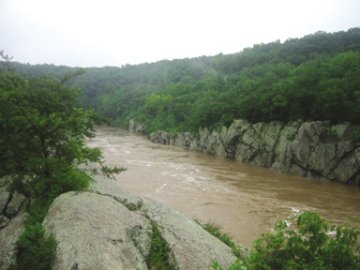Two river gorges along the Atlantic seaboard were carved out over a geologically short period, according to analyses of rock samples from the chasms.

Many large rivers that flow eastward from the Appalachian Mountains spill through narrow gorges just before they dump into the Atlantic Ocean or Chesapeake Bay. Those geologic features are often carved into bedrock that’s millions of years old, but new data hint that at least some of the chasms are much younger, says Luke J. Reusser, a geologist at the University of Vermont in Burlington.
For their analyses, Reusser and his colleagues collected quartz samples from the walls and channels of two gorges, each 10 to 20 meters deep: the 3-kilometer-long Mather Gorge on the Potomac River along the Maryland-Virginia border and the
5-km-long Holtwood Gorge along the Susquehanna River in Pennsylvania. Then, the researchers tallied the samples’ concentrations of beryllium-10, an isotope that’s typically produced when oxygen-bearing minerals, such as quartz, are exposed to cosmic rays at Earth’s surface.
Results from the Mather Gorge samples indicate that the chasm eroded downward between 37,000 and 13,000 years ago at a rate of about 80 centimeters per millennium. In the same era, erosion within Holtwood Gorge proceeded at about 50 cm per millennium. These erosion rates are tens to hundreds of times faster than scientists had suspected. The researchers report their findings in the July 23 Science.
The erosion rates for the two gorges are surprisingly similar, says Reusser. The Potomac drains an area of about 30,000 square km, while the Susquehanna’s watershed is more than twice that size. Also, during the last ice age, the Susquehanna carried meltwater from the ice sheet that invaded the northern reaches of its watershed. The Potomac had no such influx. Therefore, the scientists speculate, the boost in erosion at both locations is probably a result of other factors, such as changes in regional climate.
The processes causing erosion in these gorges today may offer clues to the past. Only a small part of the current erosion results from the abrasion of waterborne sediment, says Reusser. Much of the sculpting occurs when strong floods pluck loose chunks of rock from the gorges’ cracked walls and channels. Such floods usually occur in spring, when warm rains melt late-season snowpacks. Spring floods could have been even larger and more frequent during the last ice age, when winter snowfalls would have been greater, says Reusser.
Large spring floods during the ice age could also have resulted when meltwater built up behind ice dams and forced them to burst, says Richard B. Alley, a climatologist at Pennsylvania State University in State College.






